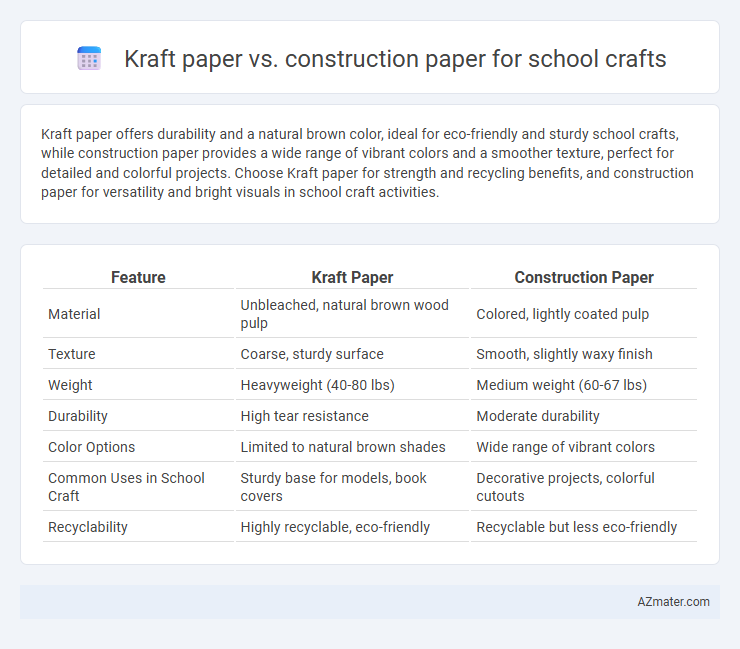Kraft paper offers durability and a natural brown color, ideal for eco-friendly and sturdy school crafts, while construction paper provides a wide range of vibrant colors and a smoother texture, perfect for detailed and colorful projects. Choose Kraft paper for strength and recycling benefits, and construction paper for versatility and bright visuals in school craft activities.
Table of Comparison
| Feature | Kraft Paper | Construction Paper |
|---|---|---|
| Material | Unbleached, natural brown wood pulp | Colored, lightly coated pulp |
| Texture | Coarse, sturdy surface | Smooth, slightly waxy finish |
| Weight | Heavyweight (40-80 lbs) | Medium weight (60-67 lbs) |
| Durability | High tear resistance | Moderate durability |
| Color Options | Limited to natural brown shades | Wide range of vibrant colors |
| Common Uses in School Craft | Sturdy base for models, book covers | Decorative projects, colorful cutouts |
| Recyclability | Highly recyclable, eco-friendly | Recyclable but less eco-friendly |
Introduction to Kraft Paper and Construction Paper
Kraft paper is a durable, coarse-textured paper made from wood pulp, known for its natural brown color and strength, making it ideal for wrapping, packaging, and school crafts that require sturdiness. Construction paper, on the other hand, is a colorful, lightweight paper made from wood pulp and recycled fibers, widely favored in school crafts for its easy-to-cut texture and vibrant hues. Both papers serve distinct purposes in educational projects: kraft paper excels in durability and rustic aesthetics, while construction paper offers a versatile palette and ease of use.
Material Composition and Production Process
Kraft paper is made from wood pulp through the kraft process, which involves chemical treatment to remove lignin, resulting in a strong, durable material with a natural brown color ideal for heavy-duty crafts. Construction paper is manufactured using a mechanical pulping process that preserves lignin, producing a softer, colored surface but less physical strength, making it suitable for lightweight school projects. The chemical composition and production methods of kraft paper ensure higher tear resistance and longevity compared to the more porous, easily torn construction paper used in classroom crafts.
Texture and Durability Comparison
Kraft paper features a coarse, fibrous texture that enhances durability and resistance to tearing, making it ideal for sturdy school craft projects. Construction paper has a smoother surface with moderate thickness, offering vibrant colors but less resistance to moisture and tearing compared to kraft paper. The choice depends on the need for robustness versus ease of cutting and folding in crafts.
Color Variety and Aesthetic Options
Kraft paper is typically available in natural brown tones, providing a rustic, earthy aesthetic ideal for eco-friendly or vintage-themed crafts, but it offers limited color variety compared to construction paper. Construction paper comes in a wide array of vibrant colors, enhancing creative possibilities and making it suitable for colorful, eye-catching school projects. The extensive color palette of construction paper allows for greater flexibility in design, while kraft paper excels in textured, neutral-toned crafts.
Cost-Effectiveness for School Projects
Kraft paper offers superior cost-effectiveness for school craft projects due to its durability and affordability, making it an ideal choice for extensive use and repeated handling. Construction paper, while available in a wider variety of colors, tends to be more expensive and less sturdy, often requiring replacement during multiple project phases. Schools prioritizing budget efficiency benefit from kraft paper's robustness and lower price per sheet, maximizing resource utilization in classroom activities.
Suitability for Different Craft Techniques
Kraft paper offers superior durability and a coarse texture, making it ideal for wrapping, stamping, and collage projects that require strength and resilience. Construction paper features a smoother surface and vibrant colors, perfect for cutting, folding, and drawing activities suited for younger students and detailed artistry. Choosing between kraft and construction paper depends on the craft technique and the need for toughness versus color variety and ease of manipulation.
Environmental Impact and Sustainability
Kraft paper, made from unbleached wood pulp, is highly biodegradable and often recycled, making it a more sustainable choice for school crafts compared to construction paper, which typically contains dyes and chemical treatments that hinder recycling and biodegradability. Construction paper's bright colors often require synthetic pigments and coatings, increasing its environmental footprint and reducing its compostability. Choosing kraft paper reduces waste and supports eco-friendly crafting practices due to its minimal processing and natural fibers.
Safety Considerations for Children
Kraft paper is often preferred for school crafts due to its natural, non-toxic composition, making it safer for children with sensitive skin or allergies. Construction paper, while vibrant and easy to use, may contain dyes and chemicals that can cause irritation or allergic reactions in some kids. Choosing kraft paper reduces exposure to potentially harmful substances, promoting a safer crafting environment for children.
Practical Classroom Applications
Kraft paper, known for its durability and natural brown color, excels in practical classroom applications such as book covers, art projects, and eco-friendly packaging due to its strength and resistance to tearing. Construction paper offers a wide range of vibrant colors and is ideal for colorful collages, cut-and-paste activities, and creative art lessons, although it is less durable and prone to fading over time. Both materials support various craft techniques, but choosing between them depends on the project's need for longevity versus visual impact.
Choosing the Best Paper for School Crafts
Kraft paper offers durability and a natural, earthy texture ideal for sturdy and eco-friendly school crafts, while construction paper provides vibrant colors and easy-to-cut properties perfect for creative, colorful projects. Choosing the best paper depends on the craft's purpose: Kraft paper suits projects needing strength and texture like paper bags or folders, whereas construction paper excels in colorful collages, cutouts, and decorations. Evaluating factors like thickness, color variety, and project requirements ensures selecting the optimal paper for effective and visually appealing school crafts.

Infographic: Kraft paper vs Construction paper for School craft
 azmater.com
azmater.com